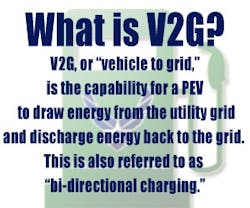EVs and Microgrids Will Miniaturize Our Grid. Or Not.
Today’s microgrids don’t always include electric vehicles (EVs). And when EVs and microgrids are paired, it seems more an homage to the future than crucial to today.
That will change, however, as consumers buy more EVs, and those EVs prove valuable not only as transportation vehicles but as worker bees for the electric grid.
EVs can serve double duty. As automated mobile energy storage units, they will be able to travel to utility substations or microgrids when needed, and along the way pick up passengers in an Uber-like fashion. At least that’s the increasingly credible vision put forward by energy and transportation planners.
But before this can happen, it’s necessary to set grid rules for EVs, a technology not imagined when current electric policies were created.
So a new report by the Institute for Local Self Reliance (ILSR) offers an interesting read because it suggests initial policies to bolster vehicle-to-grid — the exchange of energy between EVs and the grid.
“Electric vehicles are naturally good for the grid, but if we jump on the right policy now (combining smart chargers and time-of-use pricing) we can dramatically increase their benefits to the grid, customers, and drivers,” says John Farrell, energy democracy initiative director at ILSR and a co-author of “Choosing the Electric Avenue: Unlocking Savings, Emissions Reductions, and Community Benefits of Electric Vehicles.”
The rules don’t necessarily have to be complex to achieve an early payoff, according to the report.
Just encouraging EV charging during periods when demand is low on the grid can go a long way. For example, the report cites a study by that California Public Utilities Commission that found incentivizing night-time charging created net benefits of $3,600 to $5,000 per vehicle.
Pairing EVs and microgrids bolsters electric reliability
Policies that encourage pairing of EVs and microgrids helps ensure the lights stay on during a storm or calamity. “Microgrids, typically powered by solar and batteries, could use electric vehicles to soak up excess energy production — and keep it local — to provide power during extended grid outages,” says the report.
EVS also can strengthen the grid during normal operations by offering various ancillary services. The University of California-San Diego is testing how EVs and microgrids work together. The college, which has one of the nation’s largest microgrids and 70 EVs charging stations, is using EV — or specifically their batteries — to regulate grid frequency. Under the program, EV owners must be flexible in their choice of charging periods, but in turn they are compensated for allowing use of their vehicle batteries.
“This symbiosis makes electric vehicle integration a compelling prospect for microgrid operators and vehicle owners,” says the report.
To get the most out of vehicle-to-grid services, what rules and incentives need to established now? ILSR puts forward several recommendations, among them:
- Financing of private chargers by utilities, and their investment in public charging networks based on future revenue from sales of electricity to power vehicles
- Preventing utilities from monopolizing the business and instead fostering rules that allow choice and competition in charging hardware for private and public chargers
- Offering utility charging plans that include substantial discounts to EVs that charge during off-peak hours or absorb excess renewable energy
- Encouraging bundled solar and electric vehicle purchases, and deploying policies to support on-site charging from solar.
- Electrifying car-sharing and transit systems to reap the widespread health and environmental benefits of EVs and renewables
Credit: U.S. Department of Defense
For ILSR, EVs are the “cornerstone of a local energy economy,” where energy benefits accrue to local communities. With EVs, locals can earn revenue by selling services to the grid. They can get more out of their solar panels by channeling the excess power they generate into batteries for later use. They can also use the batteries to overcome certain technical issues related to solar use, such as feed issues on the grid, says the report.
Local energy also avoids the inefficiencies of transmitting electricity over long distance power lines. Electricity dissipates when transported. So generating it closer to where it’s used means less loss. Less loss means less need to build more lines or other energy infrastructure to produce and transport power.
Miniaturizing electricity grids
As ILSR sees it, EVs offer yet another step toward “miniaturizing electricity grids by giving communities control over their power when the larger grid is up or goes down.”
With so few EVs on the road, it might not seem necessary to focus on these policies yet. Only about 158,000 EVs were sold in the U.S. last year out of 17.6 million cars and trucks in total. But EV sales were up 30 percent from the year before, says the report, and future growth is expected to be exponential. Bloomberg New Energy Finance estimates EVs will make up 35 percent of auto sales worldwide by 2040.
That may seem far off, but it’s just around the corner in the utility planning world which operates in 15-year increments deciding the fate of generating resources that last about 40 years.
Indeed, today’s microgrid industry stands as a lesson learned about the value of establishing rules and policy early. Microgrids are gaining in popularity but installations are sometimes hampered by disputes over interconnections, the utility’s role, and who pays capital costs, issues regulators are trying to sort out after the fact. Regulation is chasing technology, leaving an industry begging for guideposts.
ILSR says that EVs “will upend the transportation system — and soon — and provide new ways for communities to take charge of their energy future.” With exponential EV growth ahead, “the time to adopt the right policies is now.”
Track news about EVs and microgrids by subscribing to the free Microgrid Knowledge newsletter.
About the Author
Elisa Wood
Editor-in-Chief
Elisa Wood is the editor and founder of EnergyChangemakers.com. She is co-founder and former editor of Microgrid Knowledge.
